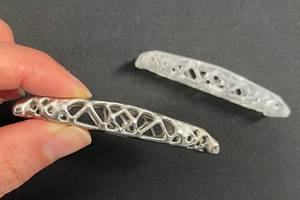Replique Enhances 3D Printing Material Hub, Expands Production Network With Traditional Technologies
Formnext 2024: Replique has also collaborated with several health care providers to develop 3D printed innovations such as a fully 3D printed containment valve and new rollator with a 3D printed frame.
Replique’s Material Hub for 3D printing now offers a direct comparison feature, enabling users to easily assess materials side-by-side and quickly choose the best option for their applications. Source (all images): Replique
Replique has enriched its Material Hub for 3D printing with metals and enhanced the user experience. The hub now offers a more intuitive experience with a new direct comparison feature, enabling users to easily assess materials side-by-side and quickly choose the best option for their applications. With the addition of metal materials for additive manufacturing (AM), customers can now qualify complex, high-strength parts with precision. Users can browse materials based on specific application requirements and access detailed property data to make informed decisions in a short period of time.
“The integration of metal materials and usability enhancements of our Material Hub represent another step toward democratizing additive manufacturing,” says Jan Weickel, technical sales manager and project manager of the Replique Material Hub. “We are excited to establish new partnerships with metal manufacturers at Formnext who want to make their materials available on our platform.”
The company has also expanded its Production Network to meet the diverse needs of customers by providing access to additional manufacturing technologies, such as forging, metal casting and injection molding. This expansion gives customers access to more than 250 production partners, enabling them to meet their sourcing needs with even greater flexibility.
“With this expansion, we are responding to our customers’ desire to source all their manufacturing needs — from individual parts to serial production — centrally and using the most suitable technology for each application. This enables companies to quickly adapt to any customer requirements in a complex procurement environment,” says Dr. Max Siebert, Replique CEO and co-founder.
Replique partnered with Zermec Pharma AG to develop a fully 3D printed containment valve that minimizes contamination and enhances production quality.
In addition, Replique is also partnering with Zermec Pharma AG (provider of secure powder transfer systems) to develop a fully 3D printed containment valve, specifically designed to meet the high standards of powder manufacturers and pharmaceutical companies focused on minimizing contamination and enhancing production quality.
“Thanks to the co-engineering with Replique, we were able to prototype the containment valve quickly and effectively,” says Jochen Knoll, Zermec Pharma AG chief customer officer. “From the start of development to the launch at Achema 2024, it took just four months. The material we used is PFAS-free, meets stringent food and pharmaceutical standards, and has sliding properties similar to PTFE. This wouldn’t have been feasible with traditional CNC manufacturing.”

Replique collaborated with RehamedPower to develop a new rollator with a 3D printed frame that simplifies assembly with fewer parts and connectors.
Replique is also collaborating with RehamedPower, a provider of rehabilitation equipment. Following the successful integration of 3D printing for the RP1 electric wheelchair — from prototyping to full-scale production — it has developed a new rollator with a 3D printed frame. This design not only meets the rising demand for mobility aids that combine style with functionality but also simplifies assembly with fewer parts and connectors.
Related Content
Possibilities From Electroplating 3D Printed Plastic Parts
Adding layers of nickel or copper to 3D printed polymer can impart desired properties such as electrical conductivity, EMI shielding, abrasion resistance and improved strength — approaching and even exceeding 3D printed metal, according to RePliForm.
Read More3D Printing with Plastic Pellets – What You Need to Know
A few 3D printers today are capable of working directly with resin pellets for feedstock. That brings extreme flexibility in material options, but also requires greater knowledge of how to best process any given resin. Here’s how FGF machine maker JuggerBot 3D addresses both the printing technology and the process know-how.
Read MoreFDA-Approved Spine Implant Made with PEEK: The Cool Parts Show #63
Curiteva now manufactures these cervical spine implants using an unusual 3D printing method: fused strand deposition. Learn how the process works and why it’s a good pairing with PEEK in this episode of The Cool Parts Show.
Read MoreUnderstanding PEKK and PEEK for 3D Printing: The Cool Parts Show Bonus
Both materials offer properties desirable for medical implants, among other applications. In this bonus episode, hear more from Oxford Performance Materials and Curiteva about how these companies are applying PEKK and PEEK, respectively.
Read MoreRead Next
Postprocessing Steps and Costs for Metal 3D Printing
When your metal part is done 3D printing, you just pull it out of the machine and start using it, right? Not exactly.
Read MoreCrushable Lattices: The Lightweight Structures That Will Protect an Interplanetary Payload
NASA uses laser powder bed fusion plus chemical etching to create the lattice forms engineered to keep Mars rocks safe during a crash landing on Earth.
Read MoreAlquist 3D Looks Toward a Carbon-Sequestering Future with 3D Printed Infrastructure
The Colorado startup aims to reduce the carbon footprint of new buildings, homes and city infrastructure with robotic 3D printing and a specialized geopolymer material.
Read More






















